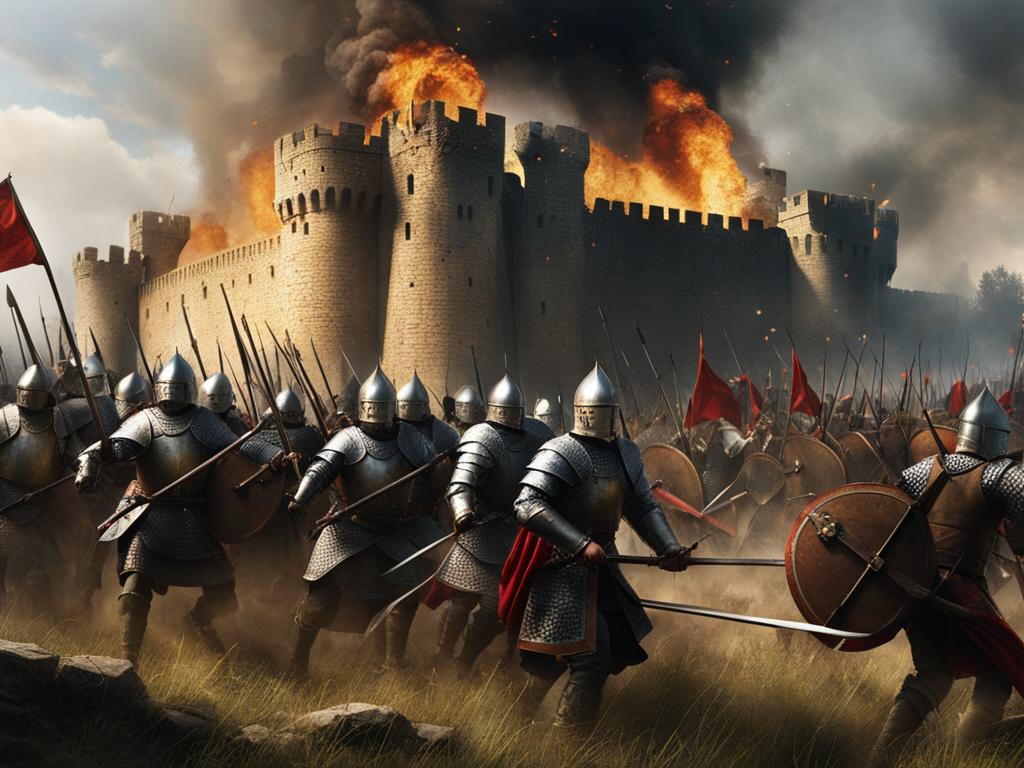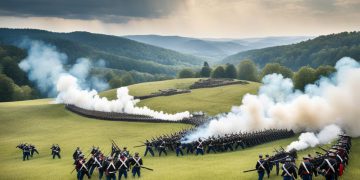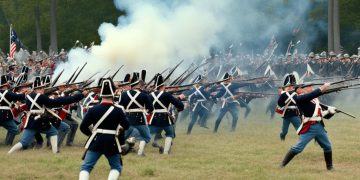Welcome to the intriguing world of Medieval Warfare! In this section, we will embark on a journey through time to uncover the fascinating weapons, tactics, and strategies that shaped historical battlefields during the Middle Ages. From the clashing of swords to the siege of castles, the medieval period witnessed a myriad of innovations and strategies that forever transformed the art of war.
Join us as we explore the evolution of combat during this period and delve into the key battles that defined medieval warfare. We will examine the role of knights and foot soldiers, as well as the defense mechanisms employed during castle sieges. Additionally, we will uncover the innovative tactics and strategies that emerged, paving the way for future military advancements.
Throughout this section, we will provide a comprehensive overview of the medieval period’s military landscape, highlighting the battles, weapons, tactics, and strategies that played pivotal roles in shaping history. So, let’s strap on our armor and journey back in time to discover the captivating world of medieval warfare.
Key Takeaways:
- Medieval warfare encompassed a wide range of weapons, tactics, and strategies that significantly influenced historical battles.
- Combat during the Middle Ages witnessed constant evolution, driven by advancements in weaponry and armor.
- Key battles of the medieval period, such as the Battle of Hastings and the Battle of Agincourt, shaped history and laid the foundations for future military strategies.
- Castle sieges required intricate defense mechanisms and siege tactics to breach fortified walls.
- Knights and foot soldiers played distinct roles in medieval warfare, with knights embodying chivalry and foot soldiers forming the backbone of armies.
The Evolution of Medieval Combat
Step back in time and immerse yourself in the fascinating evolution of combat during the Middle Ages. From the early medieval period to the Late Middle Ages, warfare underwent significant changes that shaped the course of history. In this section, we will explore the advancements in weapons, armor, tactics, and strategies that revolutionized medieval combat.
Advancements in Weapons
Medieval combat was defined by a wide array of weapons, each with its own unique purpose and characteristics. Swords, spears, axes, and maces were among the primary weapons used by medieval fighters. However, as technology progressed, new weapons emerged that had a profound impact on the battlefield.
The introduction of the longbow revolutionized ranged warfare, allowing skilled archers to rain deadly volleys of arrows on their adversaries from a significant distance. Crossbows, with their superior power and ease of use, became favored by both foot soldiers and knights. The development of siege weapons such as trebuchets and catapults enabled armies to breach fortified walls and launch devastating attacks on enemy positions.
Armor and Protection
As weapons evolved, so did the need for effective protection. Medieval warriors adapted their armor to withstand the ever-changing threats on the battlefield. Early medieval soldiers relied on chainmail and padded armor for defense. However, with the advent of plate armor in the 14th century, knights were clad in full suits of metal, providing superior protection against swords, arrows, and blunt force.
Tactics and Strategies
Alongside the development of weapons and armor, medieval armies refined their tactics to gain an advantage over their opponents. One of the most well-known tactics was the use of the shield wall formation, where soldiers formed a solid line with shields interlocked, creating a formidable barrier. Other tactics included cavalry charges, flanking maneuvers, and ambushes, each designed to exploit weaknesses in the enemy’s defenses.
The tactical skill of commanders played a pivotal role in medieval warfare. Military leaders such as William the Conqueror and Joan of Arc employed innovative strategies to achieve victory on the battlefield. From feigned retreats to surprise attacks, these tactics showcased the importance of strategic thinking in medieval combat.
Throughout the Middle Ages, the art of warfare continued to evolve. The introduction of gunpowder in the late medieval period marked a significant shift, paving the way for the use of firearms in future conflicts. However, the weapons, tactics, and strategies developed during this era laid the foundation for modern warfare and shaped the course of history.
Stay tuned as we delve deeper into the key battles of the medieval period, exploring the tactics employed by military leaders and the lasting impact of these conflicts on history.
Key Battles of the Medieval Period
Dive into some of the most significant battles of the medieval period and gain a deeper understanding of the strategies and tactics employed by military leaders. Explore the remarkable stories of valor, cunning, and strategic brilliance that unfolded on the battlefields of the past, forever shaping the course of history.
Battle of Hastings
The Battle of Hastings, fought in 1066, was a seminal event in medieval warfare and a turning point in English history. It was a clash between the Norman-French forces led by William the Conqueror and the English army under the command of King Harold. This battle marked the beginning of Norman rule in England, forever altering the political and cultural landscape of the country. The tactics employed by William, such as the use of cavalry charges and archers, proved instrumental in securing victory.
“I tell you that the battle of Hastings changed not only English history but the course of European history as well.” – David Bates
Battle of Agincourt
The Battle of Agincourt, fought in 1415 during the Hundred Years’ War, is renowned for the stunning victory of the English army led by King Henry V against the French forces. Despite being heavily outnumbered, the English employed a unique battle formation and superior longbow archery skills to decimate the French ranks. This battle showcased the power of well-strategized attacks and the devastating effectiveness of English longbowmen in medieval warfare.
“The Battle of Agincourt represented a profound triumph of intelligence, discipline, leadership and use of the longbow against overwhelming odds” – Juliet Barker
These key battles of the medieval period exemplify the importance of tactical prowess, innovative strategies, and the ability to adapt to changing circumstances on the battlefield. By studying these historical conflicts, we can gain valuable insights into the evolving nature of warfare and the enduring impact of these battles on future military engagements.
Castle Sieges and Defense Mechanisms
When it comes to medieval warfare, castle sieges were pivotal events that played a significant role in determining the outcome of battles. Castle sieges were meticulously planned and required sophisticated tactics to breach the formidable fortifications that protected the defenders within.
Defenders developed a variety of defense mechanisms to withstand the onslaught of attackers. These ingenious structures and strategies were designed to thwart the enemy’s advances and protect the inhabitants of the castle.
One of the most well-known defense mechanisms was the moat, a deep trench encircling the castle that made it difficult for assailants to approach. The moat was often filled with water and acted as a barrier, forcing attackers to find alternative ways to breach the castle walls.
Castle walls were fortified with battlements, which provided defenders with cover to shoot arrows or pour boiling oil onto the attackers below. The walls were also lined with merlons and crenels, creating a protective barrier while allowing defenders to take aim at the enemy.
The drawbridge served as both a means of entry for friendly forces and a potential trap for invaders. It could be raised or lowered, controlling access to the castle and preventing unauthorized entry.
For added protection, murder holes were strategically positioned throughout the castle. These openings allowed defenders to drop heavy objects, hot oil, or even rocks on attackers, inflicting severe damage.
The use of siege towers was another effective strategy employed during castle sieges. These towering structures provided attackers with a platform to breach the walls at a height that was advantageous over defenders.
“Castle sieges were intricate battles of wits and ingenuity, showcasing the lengths both attackers and defenders were willing to go to gain the upper hand.”
To get a visual understanding of castle sieges and defense mechanisms, take a look at the image below:
| Defense Mechanism | Description |
|---|---|
| Moat | A deep trench filled with water, forming a barrier around the castle. |
| Battlements | Fortified walls with alternating merlons and crenels, offering defense and visibility. |
| Drawbridge | A bridge that could be raised or lowered to control access to the castle. |
| Murder Holes | Openings in the castle walls used to drop objects or substances onto attackers. |
| Siege Towers | Tall structures used by attackers to gain an advantage in breaching castle walls. |
Castle sieges and defense mechanisms were an intricate dance between attackers and defenders, each side employing innovative tactics to gain the upper hand. The success or failure of a siege hinged on the effectiveness of the defense mechanisms and the ability of the attackers to devise strategies to overcome them.
The Role of Knights and Foot Soldiers
When it comes to medieval warfare, knights and foot soldiers played distinct but equally crucial roles on the battlefield. Let’s delve into their responsibilities and contributions in shaping the outcomes of historical battles.
Knights: Masters of Chivalry and Skill
Knights were the aristocratic elite of medieval society, embodying honor, courage, and prowess in combat. Trained from a young age in the art of warfare, knights were skilled in wielding a variety of weapons and heavily armored for protection. Mounted on horseback, they were a formidable force, charging into battle with determination.
“The knight is a servant of God and the epitome of valor.”
– Sir Walter Scott
The chivalric code governed the conduct of knights, emphasizing virtues such as loyalty, bravery, and respect. Their commitment to these principles earned them the admiration of society and fellow warriors alike.
Knights were often at the forefront of cavalry charges, using their lances to break enemy formations and create openings for their comrades. Their role extended beyond combat, as they also served as leaders, responsible for maintaining discipline and coordinating strategies.
Foot Soldiers: The Backbone of Medieval Armies
Foot soldiers, on the other hand, formed the bulk of the medieval armies. Consisting of peasants, militia, and mercenaries, foot soldiers were versatile and adaptable fighters who could be armed with a range of weapons, including swords, spears, and bows.
Unlike knights, foot soldiers were not heavily armored, relying on speed, agility, and numbers to overwhelm the enemy. They fought together in tightly organized formations, such as the famous English longbowmen or the Swiss pikemen.
Foot soldiers played a crucial role in battles, providing support to the knights and engaging in close-quarter combat. Their collective strength and unwavering determination often determined the outcome of clashes.
Coordination and Collaboration for Tactical Success
To achieve victory on the battlefield, knights and foot soldiers had to work together in harmony. Their coordination and collaboration were essential for executing strategies and tactics effectively.
Knights, with their superior training and resources, served as the backbone of the medieval army, leading charges and capturing key positions. Foot soldiers provided vital support, creating a shield around the knights, protecting them from flanking attacks, and engaging enemy forces on the ground.
This dynamic interplay between knights and foot soldiers allowed for tactical flexibility and adaptability, enabling medieval armies to overcome challenging situations and emerge victorious.
| Knights | Foot Soldiers |
|---|---|
| Heavily armored and skilled in combat | Versatile fighters, relying on speed and numbers |
| Leaders and commanders | Supporters and protectors |
| Wielded lances, swords, and other weapons | Armed with swords, spears, bows, and other weapons |
| Represented chivalric code and ideals | Contributed to the collective strength of the army |
Together, knights and foot soldiers formed the backbone of medieval warfare, their distinct roles blending into a synergistic force that propelled nations toward victory. Their legacy continues to inspire and captivate us with tales of honor, bravery, and the timeless pursuit of triumph on the battlefield.
Innovations in Medieval Warfare
During the medieval period, warfare underwent significant transformations with the emergence of innovative tactics and strategies. These advancements revolutionized the battlefield, reshaping the course of wars and influencing the outcome of conflicts. From the use of longbows and crossbows to the introduction of gunpowder, medieval military forces employed new methods that tested traditional strategies and pushed the boundaries of warfare.
One of the most notable innovations in medieval warfare was the adoption of longbows as a primary ranged weapon. These powerful bows, capable of shooting arrows with exceptional velocity and distance, revolutionized the dynamics of battles. The longbow allowed archers to unleash volleys of arrows from a safe distance, weakening enemy formations and causing chaos among their ranks. This strategic use of longbows played a crucial role in the famous Battle of Agincourt, where English longbowmen contributed to a stunning victory against the French forces.
Another groundbreaking innovation that had a profound impact on medieval warfare was the introduction of gunpowder. Originally developed in China, the use of gunpowder in warfare changed the nature of battle, enabling the deployment of powerful cannons and explosive projectiles. The incorporation of gunpowder weapons, such as cannons and handheld firearms, revolutionized siege warfare and laid the foundation for the emergence of modern artillery. This advancement marked a significant turning point in military history and contributed to the decline of traditional castle defenses.
“The introduction of longbows and gunpowder forever changed the face of medieval warfare. These innovations allowed armies to deliver devastating blows from a distance, altering battle dynamics and strategic planning.”
Moreover, medieval warriors also embraced the use of crossbows as an effective weapon on the battlefield. Unlike traditional longbows, crossbows required less strength to operate, making them accessible to a broader range of soldiers. Their ability to deliver lethal force with minimal training made crossbows a popular choice among infantry units. Crossbowmen could effectively penetrate armor and provide valuable support in sieges, skirmishes, and open field battles.
Furthermore, innovations in military tactics and strategies during the medieval period included the improved utilization of infantry and cavalry formations. Knights, who were initially limited to mounted combat, quickly adapted to fighting on foot as well. This flexibility allowed knights to engage in various battle scenarios, demonstrating their expertise in both mounted charges and close-quarter combat.
Innovations in Medieval Warfare
| Innovations | Description |
|---|---|
| Longbows | A powerful ranged weapon capable of shooting arrows with exceptional velocity and distance, revolutionizing battle dynamics. |
| Gunpowder | An explosive substance that enabled the development of cannons and handheld firearms, revolutionizing siege warfare. |
| Crossbows | A weapon that required less strength to operate, providing soldiers with a powerful projectile for both infantry and siege warfare. |
These innovations in medieval warfare ushered in a new era of tactics and strategies, challenging traditional methods and pushing the boundaries of military thinking. They not only impacted the course of battles but also influenced the development of warfare in subsequent eras. By understanding the innovative advancements of medieval warfare, we gain valuable insights into the strategic thinking and adaptability of historical military forces.
The Legacy of Medieval Military Tactics
As we look back on the medieval period, it’s impossible to ignore the lasting legacy of its military tactics. The strategies and lessons learned from medieval warfare continue to shape military thinking and contemporary combat practices to this day.
One of the key aspects of medieval military tactics was the emphasis on organization and discipline. Armies were trained to act as a cohesive unit, with strict formations and coordinated movements. The importance of strategy and tactical maneuvering became evident as military leaders sought to gain the upper hand on the battlefield.
Additionally, the medieval period saw the development and refinement of siege warfare techniques. These tactics and defense mechanisms, designed to breach castle walls or repel attackers, have had a significant impact on the evolution of military tactics throughout history. The ingenious methods used during castle sieges continue to inspire military engineers and strategists in modern times.
Furthermore, the legacy of medieval military tactics can be seen in the evolution of weaponry. From the longbow to the crossbow, these medieval innovations revolutionized projectile warfare. The techniques and strategies developed to maximize the effectiveness of these weapons set the groundwork for modern-day approaches to ranged combat.







